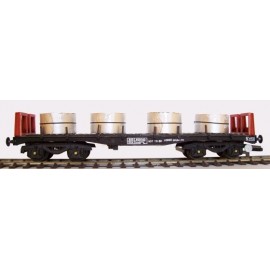There are a number of different options for attaching figures such as a horse and rider to a layout. Perhaps the...
No products
Product successfully added to your shopping cart
There are 0 items in your cart. There is 1 item in your cart.
Search Tips
What are BAA wagons?
The BAA wagons were 40 feet long, mounted on BR-designed FBT6 bogies, similar to the widely successful Y25 type. These wagons were rated for a gross laden weight of 100 tons and featured shaped solebars designed to clear the bogies, with the depth increasing at each end and in the middle. The brake control wheels were located at the outer ends of each bogie. The ends of the wagons were made from steel sections, about one metre tall and the decks were formed using inverted U-sections with mesh in between.
The first batch of these wagons, designated Lot 3792, was built at Ashford Works in 1972, consisting of 49 wagons. These wagons predated the full introduction of TOPS (Total Operations Processing System) and were assigned diagram number 1/441, marked as Bogie Steel ABs. These wagons had vacuum through pipes and ends made of five equally spaced vertical tapering sections. This batch, numbered 900000 to 900048, was later classified under TOPS as BAB (BAB-F) with design code BA001A. A second batch followed in 1972-73, also from Ashford, which omitted the vacuum pipe and was coded as BAA (BAA-F) under design code BA001B, numbered 900049 to 900124.
A further batch, Lot 3805, was built at Shildon in 1973. These wagons had slightly different ends, made up of four vertical sections with a central gap. Seventy-four wagons were constructed under design code BA001B, numbered 900125 to 900198. Subsequent production returned to Ashford in 1975, producing Lot 3858. This batch, numbered 900200 to 900273, had modifications to the wagon ends and was classified under design code BA001C. The final batch, Lot 3860, was built in 1976, consisting of 32 wagons with a revised TOPS code of BAA-M (for metric). These wagons featured a deeper solebar and altered bogie centring, leading to a resemblance to BBA wagons.
Modifications to some wagons were introduced not long after they entered service. Many were fitted with coil cradles, though this did not always lead to changes in their TOPS code. However, wagons that had two longitudinal beams fitted to create a channel for coil transport were recoded as BKA or BKB, known informally as "kinky beam" wagons. The BAB wagons saw the gradual removal of their vacuum through pipes, with the entire batch recoded by 1992 as design BA001D. In 1991, one BAA wagon was modified at Motherwell to carry steel coils, receiving a solid floor, coil cradles, and tall ends, and recoded as a BKA-D.
From 1992 onwards, several new TOPS codes were introduced for modified wagons intended to carry steel coils. BYA and BZA wagons, with 30-ton and 25-ton capacities respectively, became common. The BYAs had four transverse cradles, while the BZAs featured five longitudinal cradles. By the end of 1992, there were 106 BZAs and 14 BYAs in service. Another variation, the BXA, appeared in 1993, combining transverse and longitudinal coil cradles, and 25 of these were in use by the end of the year.
By mid-1994, the fleet consisted of 133 BAA, 2 BKA, 24 BXA, 141 BZA, and 2 FOA wagons, totalling 302. This steel fleet was later divided between two regional railfreight companies, Transrail and Loadhaul. A further development came in 1994 when 55 BAAs were converted to BCAs, designed to carry coils in box-like cradles with their ends and floors removed.
In 1996, English, Welsh, and Scottish (EWS) Railway took control of the fleet, bringing them back under one company. Some wagons were fitted with new three-piece bogies and issued new design codes. By the early 2000s, the fleet had reduced slightly, with some wagons withdrawn due to the introduction of newer steel-carrying wagons. Despite these reductions, the BAA wagons, with their various modifications and new codes, played a key role in the transport of steel throughout the 1990s and early 2000s.
Click here to receive the tips weekly in your mailbox. You can unsubscribe at any time.








